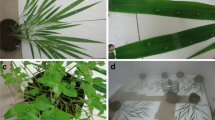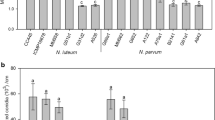Abstract
Botrytis cinerea was isolated from Geraldton waxflower (Chamelaucium uncinatum) flowers collected in Queensland and Western Australia. Isolates were shown to be pathogenic on the two flower selections used, ‘Herb Morrow’ and ‘Alba’. Separation of the flower from the pedicel occurred for single cut flowers inoculated with the fungus. This observation supports the hypothesis that infection commonly contributes to premature flower drop in cut, packaged Geraldton waxflower.
Similar content being viewed by others
References
Agrios, G.N. (1988)—Plant Pathology (3rd. Ed.). Academic Press Inc. San Diego.
Barnett, H.L. and Hunter, B.B, (1972) — Illustrated Genera of the Imperfect Fungi (3rd. Ed.). Burgess Publishing Company, Minneapolis.
Blombery, A.M. (1973) — What Wildflower is That? Paul Hamlyn. Sydney.
Elad, Y. (1990) — Production of ethylene by tissues of tomato, pepper, french bean and cucumber in response to infection by Botrytis cinerea. Physiological and Molecular Plant Pathology 36:288–289.
Ellis, M.B. and Waller, J.M. (1974) — Sclerotinia fuckeliana (Conidial state: Botrytis cinerea). CMI Descriptions of pathogenic fungi and bacteria 431. Commonwealth Agricultural Bureaux. Farnham Royal, Slough, U.K.
Faragher, J. (1988) — Postharvest handling of flowers — beyond the basics. In Proceedings of the Australian Floriculture Conference (Eds K.A. Handreck, T.A. Reichstein and J.F. Roach), pp. 107–116. Adelaide, 1988.
Joyce, D.C. (1988) — Postharvest characteristics of Geraldton wax flowers. Journal of the American Society for Horticultural Science 13:738–742.
Joyce D.C. (1993) — Postharvest floral organ fall in Geraldton waxflower. Australian Journal of Experimental Agriculture 33:481–487
Reid M.S. (1985) — Ethylene and abscission. Hort-Science 20:45–50.
Reid M.S. (1992) — Postharvest handling systems: Ornamental crops. In Postharvest Technology of Horticultural Crops (Ed A.A. Kader), pp. 201–209. University of California. Oakland.
Tomas, A,, Wearing, A.H. and Joyce, D.C. (1992) — Geraldton waxflower, flower abscission and Botrytis: a hypothesis. In High Quality Horticulture, Practices and Products, pp. 17–19. Australian Society for Horticultural Science Inc. Regional Technical Meeting, 29 August 1992, Brisbane.
Wearing, A.H. and Joyce, D.C.(1994) — Botrytis cinerea on Geraldton waxflower. In 1994 National Workshop for Australian Native Flowers. pp. 11.22–11.24. University of Queensland, Gatton College, 8–10 February 1994, Lawes.
Author information
Authors and Affiliations
Rights and permissions
About this article
Cite this article
Tomas, A., Wearing, A.H. & Joyce, D.C. Botrytis cinerea: a causal agent of premature flower drop in packaged Geraldton waxflower. Australasian Plant Pathology 24, 26–28 (1995). https://doi.org/10.1071/APP9950026
Accepted:
Issue Date:
DOI: https://doi.org/10.1071/APP9950026




